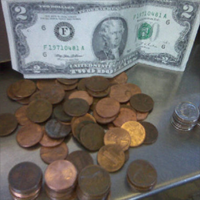I spent the five happiest years of my life in a morgue. As a forensic scientist in the Cleveland coroner’s office I analyzed gunshot residue on hands and clothing, hairs, fibers, paint, glass, DNA, blood and many other forms of trace evidence, as well as crime scenes. Now I'm a certified latent print examiner and CSI for a police department in Florida. I also write a series of forensic suspense novels, turning the day job into fiction. My books have been translated into six languages.
Many forensic chemistry departments only analyze possible drugs, so I would think it would be possible to find.
I’m so sorry for your loss. My advice would be to use rubber gloves and take the items to a porch or some dry outside spot if it’s not going to rain for a while, or the garage or utility room if so. If you’re sensitive to smells you might use swimmers nose plugs or a bandana tied over your face. Spread the items out on a clean paper bag or newspaper (or wax paper if there’s some pieces of paper in his wallet you want to keep. Anything that can be wet, like car keys or plastic cards, dip or wash them in a container of water with some bleach in it, then let dry. Let all the stuff in the wallet dry if necessary, then keep what you want and discard the rest. Some of the smell will dissipate the longer its left to dry but if it’s something that can’t be soaked in bleach, you may never get a smell completely out, as far as I know. Best of luck.
I'm sorry, but again that is way too broad a question. Most forensic science is based on biology, physics and chemistry, so it's all 'natural' science.
As far as I know, no. The DNA tests of the shirt will just show a mixture of the victims, so that the analyst would only be able to say the blood could have come from these two or three people--in other words there are no alleles that definitely couldn't have come from those three. But because it is a mixture, they can't say it did come from these three exact people. And they couldn't tell, again as far as I know, which blood was deposited first.
Track and Field Coach
 Do you let your athletes play another sport in the off-season?
Do you let your athletes play another sport in the off-season?
Veterinarian
 Do you think keeping monkeys as pets is a bad idea?
Do you think keeping monkeys as pets is a bad idea?
Toll Collector
 What happens when a car blows past a tollbooth without paying?
What happens when a car blows past a tollbooth without paying?
Biology would help with the natural fibers (like cotton or fibers from plants, or hairs from animals like wool) and chemistry helped with analyzing synthetic fibers with polarized light or fourier transform infrared spectroscopy. Those last two don't work on natural fibers because they're not consistent all the way through like a synthetic fiber, that comes out of a machine.
Fiber analysis was usually only examined in cases of stabbing, strangling or bludgeoning, where there had to be close physical contact between victim and suspect. (A gunshot didn't mean there had to be contact.) It was only a small part of my days. Very little is done any more because you can only say the fibers are consistent with having come from a particular sample, you can't say they did, as in DNA or fingerprints. You can't even give a statistic for how likely it would be to find a particular fiber unless it came from the suspect, etc., because we can't know how many items with that fiber are in the environment.
Only collection would be done in the field, to do anything more you would need the microscopes and the equipment at the lab.
Hope that helps!
That's called the 'CSI Effect' and it can be a problem for juries to have unrealistic expectations. One instructor described it as "Juries don't know as much as they think they know, but they really do know a lot more than they used to know."
Hi, sorry I didn’t get back to you sooner. Again, titles and job requirements aren't uniform, so the only way to know is to call the crime labs in your area or whereever you might be interested in working and ask them. You can also go on the websites for professional organizations such as the American Academy of Forensic Sciences and check out their job vacancy postings and see what the various positions require. Good luck.
-OR-
 Login with Facebook
Login with Facebook (max 20 characters - letters, numbers, and underscores only. Note that your username is private, and you have the option to choose an alias when asking questions or hosting a Q&A.)
(A valid e-mail address is required. Your e-mail will not be shared with anyone.)
(min 5 characters)
By checking this box, you acknowledge that you have read and agree to Jobstr.com’s Terms and Privacy Policy.
-OR-
 Register with Facebook
Register with Facebook(Don't worry: you'll be able to choose an alias when asking questions or hosting a Q&A.)